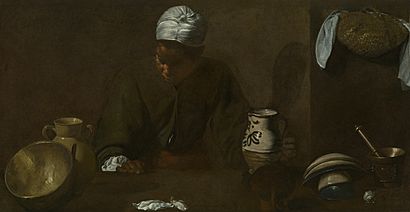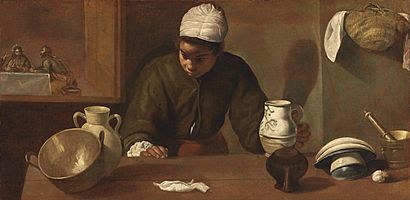The Kitchen Maid facts for kids
Quick facts for kids The Kitchen Maid |
|
|---|---|
| Spanish: La mulata / La cocinera | |
 |
|
| Artist | Diego Velázquez |
| Year | c. 1620–1622 |
| Medium | Oil on canvas |
| Dimensions | 55 cm × 104.5 cm (22 in × 41.1 in) |
| Location | Art Institute of Chicago |
| Kitchen Maid with the Supper at Emmaus | |
|---|---|
| Spanish: La cena de Emaús (La mulata) | |
 |
|
| Artist | Diego Velázquez |
| Year | c. 1620–1622 |
| Medium | Oil on canvas |
| Dimensions | 55 cm × 104.5 cm (22 in × 41.1 in) |
| Location | National Gallery of Ireland, Dublin |
The Kitchen Maid and Kitchen Maid with the Supper at Emmaus are two famous paintings by Diego Velázquez. He was a Spanish artist. He painted them early in his career, around 1620 to 1622. One painting is in the Art Institute of Chicago. The other is in the National Gallery of Ireland in Dublin.
These paintings show a scene from a kitchen. They are called "domestic paintings" because they show everyday life. Some people call the paintings La mulata or La cocinera in Spanish.
The Dublin painting was given to the museum in 1987. In 1933, the painting was cleaned. During cleaning, a hidden scene was found. It showed Jesus having supper at Emmaus. This scene was painted on the wall behind the main figure.
Contents
Two Paintings, One Artist?
The Chicago painting was bought in 1927. At first, many experts thought it was the original Velázquez painting. This made the Dublin painting seem like a copy.
However, some art experts later thought differently. They believed the Dublin painting was indeed by Velázquez. They had doubts about the Chicago painting. This was because the Chicago painting was not in very good condition.
One expert, Jonathan Brown, thought the Chicago painting might be by Velázquez. But he also suggested it could be a copy. He thought another artist might have made many copies. This artist would have wanted to use Velázquez's popular style.
Restoring the Chicago Painting
The Chicago painting was cleaned and fixed in 1999. Even with some paint missing, the best parts looked very good. Some parts even looked better than the Dublin version.
Experts did not find any signs that the Chicago painting had a religious meaning. It seemed to be just a painting of a maid working in a kitchen.
The Chicago painting shows some amazing art skills. For example, the maid's head covering has many detailed folds. The light and shadows on it are very carefully painted. The crumpled cloth in the front also shows great detail.
The way light shines on objects is also very skillful. Look at the glazed jug the maid holds. You can see the shine of the glaze. You can even see marks from when it was made on a potter's wheel.
Some people think Velázquez might have painted the Chicago version later. He might have wanted to improve on his earlier work. He focused on making the textures and objects look very real. He might have cared less about any religious message.
Who Inspired Velázquez?
Artists often get ideas from other artists. Velázquez might have been inspired by Flemish pictures. These were made by artists like Jacob Matham.
The hidden "Supper at Emmaus" in the Dublin painting made some wonder. Did Velázquez get ideas from Caravaggio? Caravaggio was an Italian painter. It's hard to know if Velázquez saw his works in Seville.
Another Version Found
In 2018, a third version of the painting was found. It is at the Museum of Fine Arts, Houston. This version is like the Chicago one. But it is cut down on the sides, making it almost square.
See also
 In Spanish: La mulata para niños
In Spanish: La mulata para niños
- List of works by Diego Velázquez

